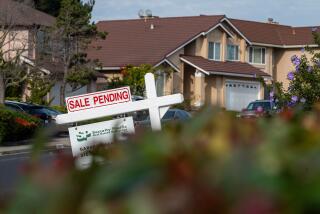Tax-Free Exchanges Unharmed by New Rules
- Share via
QUESTION: I have read a number of articles that indicate Congress was trying to significantly modify or repeal the so-called “tax-free exchange” concept. Did Congress do anything this year in this area, and what rights are still available for investment property owners?
ANSWER: You are correct that Congress has attempted to place significant restrictions on the so-called “tax-free exchange.” Indeed, at one point, many of us thought that Congress would enact legislation that would require a strict interpretation of the “like-kind” rule.
Technically speaking, Section 1031 of the Internal Revenue Code requires that there be like-kind exchanges. However, over the years both the Internal Revenue Service and the Tax Court have made it clear that the term “like-kind” refers to the nature or character of the property and not to its grade or quality.
Therefore, whether real property is improved or unimproved has been irrelevant.
Indeed, as long as one was trading real estate for real estate, the IRS took the position that it qualified as a Section 1031 Exchange. Thus, it is possible to exchange a farm for an office building, or a condominium investment unit for a seaside resort investment.
Recently, Congress wanted to restrict these exchanges so that they would truly be like-kind--in other words, a farm for a farm, an office building for an office building.
Fortunately for real estate investors, Congress did not enact any such restrictions this year. In the Revenue Reconciliation Act of 1989, passed by the Congress on Nov. 22, the impacts on like-kind exchange were rather technical.
First, Congress indicated that the like-kind exchange would not apply when the property received in such an exchange between related persons is disposed of prior to two years after the date of the last transfer in the exchange.
“Related persons” are basically persons who bear a relationship to the taxpayer, such as a family member. There are many other complex rules contained in the Tax Code that define related persons, but they are outside of the scope of this topic.
Additionally, Congress did put one limitation on like-kind property. Property located outside the United States does not qualify as property of a like kind, and therefore does not benefit from the sale and exchange provisions.
Aside from these two limitations, the so-called “tax-free exchange” is one of the few remaining tax shelters available for investors in real estate.
Here is how it works, with one caveat: This is a highly complex area, and one that often triggers scrutiny by the IRS. You should not engage in such an exchange without obtaining competent assistance from your tax advisers and your legal counsel.
In the good old days of several years ago, when real estate investments could be depreciated over 15 to 18 years and the maximum tax on capital gains was 20%, tax-free exchanges were not common. Investors usually bought property, took the maximum depreciation permitted by law, and--when they decided to sell the property--benefitted from the low tax rate on capital gains.
Under the new tax law, however, the rate of depreciation has been stretched out to 27.5 years, or 31.5 years in some instances. And capital gains are now handled as regular income, which means that they can be taxed as high as 28% to 33%.
Under these conditions, investors are beginning to look at the tax-free exchange as a method of selling their current investment property and picking up new property.
Section 1031 of the Internal Revenue Code, which deals with tax-free exchanges, says:
“No gain or loss shall be recognized if property held for productive use in trade or business or for investment . . . is exchanged solely for property of a like kind to be held either for productive use and trade or business or for investment.
It should be noted that a tax-free exchange does not eliminate the tax on the profit made on investment property. It merely defers the tax on the gain. Ultimately, when the investment property is sold--and no further exchanges are made--the taxpayer must pay the gain on the overall profit.
The statute permits nonrecognition of a gain only if the following conditions are met:
First, the property transferred and the property received by the taxpayer must be “property held for productive use in trade or business or for investment.” Thus, your personal residence will not qualify because it is not investment property.
Second, there must be an “exchange.” The IRS wants to ensure that a transaction that is called an exchange but looks like a purchase and sale is not, in effect, only a purchase and sale. For example: A sells property to B for cash, and then buys C’s property. This is truly a purchase of the C property and a sale of the A property. But if A exchanges property with C, and C then sells A’s former property to B, this can qualify as a tax-free exchange if all of the other elements are present.
Although A ends up with C’s property and B ends up with A’s property in both scenarios, the first is more traditionally a purchase and sale, while the latter is more traditionally a tax-free exchange.
The form used in obtaining the end result is important, and that is what the IRS considers when it reviews tax-free exchanges.
Third, the properties exchanged must be of a “like kind.” The courts have given a wide-ranging definition to the term “like-kind exchange.” As a general rule, all real estate is considered to be like all other real estate. For example, raw land may be exchanged for an apartment building, a farm for an apartment complex, or an apartment complex for commercial or industrial property.
Once you meet these tests, you then have to determine the tax consequences. If you do a traditional like-kind exchange, the profit you will have made on the first property will be deferred until you finally sell the exchange property. However, the cost basis of the new property in most cases will be the basis of the old property transferred without the recognition of a gain.
You must discuss this with your accountant to determine whether the savings to you in a like-kind exchange will make up for the lower cost basis on your new property.
What this means is that although you will be able to depreciate the new property under the terms of the Tax Reform Act of 1986--over 27.5 years for residential property or over 31.5 years for non-residential property--the basis of the depreciation may be what you paid for the first property in the first place--minus any depreciation which you may already have taken. It is complicated.
However, not everyone is able to find like property to exchange before they sell their investment property. In one case involving a man named Starker, the Tax Court held that the exchange does not have to be simultaneous. In the Starker case, the court held that “simultaneity of transfer” is not a requirement for nonrecognition of a gain under the tax code. Starker sold property and sometime later purchased new property, and then successfully claimed that this was a “sale and exchange.”
Congress was concerned about the expansion of the like-kind exchange concept. When it passed the Tax Reform Act of 1984, it put two major limitations on nonsimultaneous exchange. First, the property to be received by the taxpayer--your new property--must be identified as such before the 45th day after the date on which the property is transferred.
Second, the new property must be received no later than 180 days after the taxpayer transfers his original property.
The tax-free exchange remains a valuable tool for deferring taxes on gains on investment property.
Questions of general interest will be addressed in this column. Questions may be sent to Kass at 1050 17th St. N.W., Suite 1100, Washington, D.C. 20036.
More to Read
Inside the business of entertainment
The Wide Shot brings you news, analysis and insights on everything from streaming wars to production — and what it all means for the future.
You may occasionally receive promotional content from the Los Angeles Times.










